


 |
 |
GOD BLESS AMERICA
In Remembrance
September 11, 2001 |
 |
 |
|
 |

 === Please visit
my Christmas page ===
**
Please note: All photos on this page are my own.
=== Please visit
my Christmas page ===
**
Please note: All photos on this page are my own.
Please do not use without my prior authorization. Thanks.
**
 Ducks in Florida
Ducks in Florida
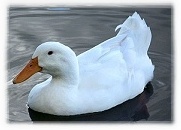
I currently feed three groups of ducks. One group is located where I work. There's a nice lake there, with a fountain in the middle. There are a lot of Muscovies, and
a few mallards, about a dozen on any one day. Among them is 'Broken Wing', who has been there many years. I knew him as a duckling.
Apart from that, there is a nice retention pond near our home, which has anywhere from a dozen to about 75 mallards. It's easy enough to bike to, but in the winter, the pond is often empty, so there are no ducks.
Finally, there's a large pond/small lake (a 10 min. bike ride
away) with about 25 pekin ducks, lots of ibises, and a few moorhens, grackles, geese, mallards, and muscovies.
I try to bike there once in a while when the weather is cool enough. The Pekin numbers are going down because they're not having ducklings (see below). As of Jan. 08, there were 6 left.
Ducklings
There haven't been any pekin ducklings, and from what I've read, there aren't likely to be. It seem Pekins are bred specifically so that they don't have any maternal instinct. That means females will lay eggs but won't sit on the eggs. Now, when they're raised on a farm, the eggs are put in incubators, but here in the wild, the eggs just die on their own. For that reason, the number of Pekins at the pond seems to go down each time I visit. Sad.
The mallards I feed seem to be rather lazy. So far I haven't seen any mallard ducklings, and I know there are females in that lot. I wish they'd get going!
For Muscovies, duckling production isn't a problem. They have broods 3 to 4 times a year, regardless of season. The moms aren't very good moms (but then ducks rarely are), so most babies don't make it to adulthood. Only about 3 or 4 out of every 14-egg brood survives. There's a number of reasons for this: lack of fear on the part of the ducklings who just wander off on their own, lack of interest of the moms to protect their young, other ducks killing the little ones (I've seen this happen - the other ducks will literally seize a baby and try to strangle it. I've intervened a few times but I can't always be there), cold weather (and the resulting lack of food), and predators. Those who are born in the winter are especially at risk. Still, with as many females as this pond has (and as forceful as the males are - being twice the size of the females helps), there's never really any danger of the population going down.
 Waterfowl
Waterfowl
At most area ponds and lakes, you can often see these beautiful water birds:
| • American Coot |
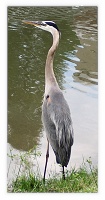 |
• Common Moorhen |
| • Osprey |
• Spoonbill |
| • Little Blue Heron |
• Great Blue Heron |
| • Tricolor Heron |
• White Ibis |
| • Cattle Egret |
• Great Egret |
| • Snowy Egret |
• Sandhill Crane |
| • Laughing Gull |
• Ring-billed Gull |
| • Wood Stork |
• Anhinga/Cormorant |
 Ducks in Belgium
Ducks in Belgium
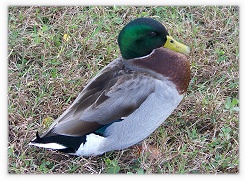
When I lived in Belgium, I used to have about 100 wild ducks. They would spend the majority of their time in our yard,
and they were lucky to have a narrow little stream close
by. We gave them old bread that we got from the bakery (day-old bread or
worse) for free. I remember we brought home several garbage bags full of
bread every week. We mainly had mallards, with a few exceptions. We did have some drastically different ducks
that were 1.5 times as big as mallards. There were 4 originally. 2 were
white (one male and one female) and 2 were black & white (one male and one
female). They were the only ones of their species around and they always
traveled together -- you could never find one alone. The black & white
female had a face that was white with what looked like black aviator
goggles... so we called her "the aviator". Both females had ducklings, which were not mixed with
mallards, but resulted directly from black & white ducks. They were all
either white or black & white, and all were raised together by the B&W group.
The following year, instead of 4 ducks, we had about 20, always
together naturally. These ducks cared very
much for their young (a rare trait in ducks) and they made sure they were well taken care of.
On one or two occasions, one or two mallards made it inside our home. Since there is generally no A/C in Belgian houses,
when summers are hot (and there's always a heat wave at some point), you have to open all doors and windows to survive the heat.
Well, when we opened the door, a couple of hungry ducks came in and found us eating in the dining room. We had to chase them out...
fortunately, there were no "accidents" (ducks tend to relieve themselves anywhere, anytime) 
Out of the 100+ ducks (I lost count),
about a third was named. Every duck
had a different personality. And each duck that I could recognize easily
was named. I won't go into the names here.
I guess after living with them for several years, you start telling them
apart. Of course, the yearly molting process made it more difficult to identify some
of the ducks. At that time, the males start to look like the females, that is, they become grey/brown, and lose their distinctive blue and green plumage.
They also lose their flying ability for about a month.
Ducklings
Part of the fun of having ducks around was springtime, when mothers
and their ducklings started running around the yard. It was also a time of
close supervision by ... us! Always on the lookout for lost or abandoned
ducklings. Unfortunately, ducklings are born in a unforgiving world. With the exception of the "black & whites", mothers are rarely very involved
with their ducklings, and usually do not care whether
the ducklings survive or not. So it is not uncommon to find abandonned
ducklings that didn't run fast enough to follow their mom, or ducklings
that have drowned when their mother left without helping them out of the
water. I've rarely seen a more cruel environment for the young. Anyway,
sometimes, mothers that did care about their young were found dead in our
yard or in the stream, killed by local townspeople. Just heartbreaking. A
few times, we found little ducklings lost, all cuddled up together on the
side of the yard, their dead mother just a few yards away... Needless to say, with dogs and cats all around,
most didn't have a chance. As we learned the hard way, when ducklings are too young, it's no use trying to save them... they won't make it.
I still remember the horror stories of little abandoned ducklings that we saved from the local wildlife only to find dead the next morning.
 But out of all the stories, some are heart-warming.
We raised about a dozen ducklings, at different times.
If they are old enough when you find them (more than a couple of days), then it's really not too
hard to raise them. We used to have a cardboard box for them... open at the top, sometimes with a cardboard wall in the middle with a door... a "2-room house"!
We also carved "windows" on each side so they could see outside (of their box; with an inside view of our house). The windows were lined with plastic wrap.
Of course, the box was lined with newspaper, which you have to change at least 2x a day! In the second room, i.e. the "kitchen", was water.
On top of the box, a rack, to keep the little creatures from running loose around the house. (Let me mention again that ducks will relieve
themselves about every 5 minutes). Every day, they got a bath in our kitchen sink, a weighing session, and 3 meals. Their usual menu: lettuce
(given to them in their bath in the sink) , tomatoes, cheese, chips, and anything else they liked.
But out of all the stories, some are heart-warming.
We raised about a dozen ducklings, at different times.
If they are old enough when you find them (more than a couple of days), then it's really not too
hard to raise them. We used to have a cardboard box for them... open at the top, sometimes with a cardboard wall in the middle with a door... a "2-room house"!
We also carved "windows" on each side so they could see outside (of their box; with an inside view of our house). The windows were lined with plastic wrap.
Of course, the box was lined with newspaper, which you have to change at least 2x a day! In the second room, i.e. the "kitchen", was water.
On top of the box, a rack, to keep the little creatures from running loose around the house. (Let me mention again that ducks will relieve
themselves about every 5 minutes). Every day, they got a bath in our kitchen sink, a weighing session, and 3 meals. Their usual menu: lettuce
(given to them in their bath in the sink) , tomatoes, cheese, chips, and anything else they liked.
After a few weeks, when they were big enough, we took them outside where we
built a "pen" made of plywood on 3 sides. The 4th side had netting, so
they could see out. Of course, they only got out when the weather was nice.
This way, they were able to run around on the grass all day. We did have another small piece of plywood nailed to the top,
at one of the corners of the enclosure in case it rained, and they needed a little shelter. At that point, the ducklings had their food
remain in the enclosure all day. As the enclosure became incredibly littered and smelly, we moved the "fence" to another location,
and left the grass in the old location to come back to life on its own. After a few months, we opened the net and let the ducks out.
We didn't force them out... we just let the thing open so they were free to go into the world at their own pace.
 Here are a few of our stories:
Here are a few of our stories:
Titi was the first duckling we ever raised and he (actually, she) was also the most
successful attempt. We raised her after finding her alone in our yard.
She grew quickly and was soon able to live on her own. Even after her release, we still found her in the yard every day. She became just a normal duck...
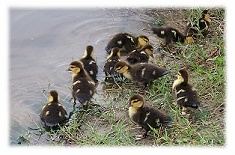 Our next successful attempt was when we found one
of the mother ducks, which we knew well, dead in the stream. We knew she had 5 ducklings. However, we only found 4 that day.
Cuddled on the side of the yard, they looked just pitiful ... and so small!! They were quite scared, and of course, as soon as they saw us,
they started running in all directions. I'm sorry to say one of the ducklings died in our attempt to rescue it.
The other 3 we were able to pick up and bring inside our home. They grew well and formed a good group, always remaining together.
They were light brown, dark brown (both female), and yellow turning to white. These are the last ducks we let go before we moved to the States.
I'm sure they did well.
Our next successful attempt was when we found one
of the mother ducks, which we knew well, dead in the stream. We knew she had 5 ducklings. However, we only found 4 that day.
Cuddled on the side of the yard, they looked just pitiful ... and so small!! They were quite scared, and of course, as soon as they saw us,
they started running in all directions. I'm sorry to say one of the ducklings died in our attempt to rescue it.
The other 3 we were able to pick up and bring inside our home. They grew well and formed a good group, always remaining together.
They were light brown, dark brown (both female), and yellow turning to white. These are the last ducks we let go before we moved to the States.
I'm sure they did well.
There were numerous other failed attempts. Some little ducklings were just too small and had no idea about anything (I guess they're not born with instinct).
Some ate the paper towels we had put down in their box (last time we did that!) and died. Another couple of ducklings we found dead in the water bowl,
which was empty... did they drink the whole thing? We never found out, but never left the water bowl in the box at night again.
There were others... I remember every time we would rescue ducklings, I knew going to bed that night that those babies could very well not be alive
the next day. But compared to being left outside, they sure had a better chance. There are many predators outside - not only cats and dogs,
but also other ducks. As I said, it's a cruel world for baby ducks.
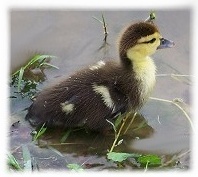 There were two other ones that we rescued.
They were fairly big, so we thought they would do fine. As they grew, we soon realized there was a problem. They had probably
been rejected from society. The brown one's back was arched - he was a hunchback!! (never knew ducks could be this way) He really was beautiful,
and in good health. The yellow one grew very nicely, until he started to lose a little weight. From then on, he became more ill every day, until he could
hardly walk and looked just miserable. We took good care of him until the end. Very sad. Anyway, we released the other one into the wild.
It's only later that we found out on the news that there was a disease that affected ducks (same symptoms our Noah had),
which was very contagious. Humans could catch it, so we were reminded not to touch these ducks... Oops! Fortunately, we never got anything from it.
There were two other ones that we rescued.
They were fairly big, so we thought they would do fine. As they grew, we soon realized there was a problem. They had probably
been rejected from society. The brown one's back was arched - he was a hunchback!! (never knew ducks could be this way) He really was beautiful,
and in good health. The yellow one grew very nicely, until he started to lose a little weight. From then on, he became more ill every day, until he could
hardly walk and looked just miserable. We took good care of him until the end. Very sad. Anyway, we released the other one into the wild.
It's only later that we found out on the news that there was a disease that affected ducks (same symptoms our Noah had),
which was very contagious. Humans could catch it, so we were reminded not to touch these ducks... Oops! Fortunately, we never got anything from it.
Now, there is one duck that I know of that did make it
literally on its own. We saw she was doing well, so there was no reason to catch her and try to raise her. We did rescue her a couple times, but we released her
right away. She was very smart and able to care for herself. At first, we found her in the large water container we had outside for the ducks.
She was so little at that time that she was unable to come out. So we helped her out! The next time, we found her in the stream, again unable
to come out (the stream had steep banks). So in the water we went. I remember we picked her from the water while she was really scared
and trying to hide from us. We were finally able to pick her out of her hole and put her back on dry ground. At that point, we figured Mo´se
(Moses in French - we didn't pay attention to gender at the time) would be an appropriate name for her. A little later, her mother was killed...
and Mo´se was left to fend for herself. Fortunately, she was tenacious and grew up just fine among the other ducks.
Now, the way we were always able to tell her from the others was that the lower part of her bill was a little longer that the upper part.
Not a lot longer, but still, enough to recognize her easily. It's kind of hard to see on the picture, though.
It was really quite strange... I don't even know how it happened. Didn't seem to affect her in any way.

 In the News
WINTER 2007-08
In the News
WINTER 2007-08
Recently, a coot (American or common, I can't tell) has started to attend the regular feedings at the pond. At first, he (or she, who knows) was very shy, and would stay away. He never
joined the ducks. However, one day I was able to throw him some bread, and he's apparently developed a taste for it. Scratch that, he's become addicted to bread!
At first, he wouldn't come too close but he'd get the bread and then swim out very fast and find a quiet spot to eat it. These days, he's usually already there
when I arrive, and while he's still shy, he'll come a lot closer now - sometimes even out of the water! (something he never used to do) to get first dabs on the bread.
He's even stolen some from nearby ducks! He still often takes the bread in his bill and leaves with it, eating it on his own, far from the commotion. But then he'll come back
for another piece. He's a lonesome creature, and the only one of his kind at this pond.
I'll post photos of him as soon as I can.
Older duck news are here.


 Pictures
Pictures

 Early 2006 pictures
Early 2006 pictures


Fla. Softshell turtle
|| Softshell swimming
|| Red-eared slider
|| Algae-covered shell
Ibis
|| Ibises
|| Moorhen & mallard
|| Pekins
|| Ducklings, 2 weeks old
|| Bridge
Herons:
Great blue heron
|| Up close and personal
|| Looking out
|| Perfectly still
 Late 2005 pictures
Late 2005 pictures

Turtle
|| Turtle under water
|| Coming out to eat
|| Alien eyes
|| Pekins and their friend
Chess, Blackie, and Tux
|| Chess on picnic table
|| Blackie, Chess, and Tux
~ Ducklings ~
10 ducklings walking on the beach
|| Going to the pond
|| The lucky seven
With Black Head
|| With White Head
|| Waiting for lunch
|| One duckling
The ducklings on 10-11, pre-teens
|| On 10-20, teenagers
|| On 10-25, young adults
 Mid 2005 pictures
Mid 2005 pictures

Pekin posing for a picture
|| Looking up at me
|| "Are you taking a picture of me?"
'Broken leg' leaning on one side
|| Looking pretty for the picture again
|| The lovely couple
Some sort of pekin mix?
|| Pekins running
|| Running through tall grass
|| Pekins swimming
Pond where pekins live
|| Geese at the pekins' pond
|| Male muscovy
|| Male mallard
Mallard female - dark
|| Mallard female - light
|| Mallards
|| Mallards again
~ Ducklings ~
White-headed muscovy female's brood
|| In the water
|| Staying close to mom
|| Hi mom
Getting older
|| A rainy day
|| Mixing with mallards
|| Mom watching over the kids
Lunchtime
|| 'Can we go home now?'
|| Getting bigger still
|| Swimming alone now
Teenagers
|| 'Aren't I cute?'
|| The gang
|| Posing for the picture, again
The gang, now young adults
|| Almost fully grown
|| Mom
|| Mom and Junior
Black-headed muscovy female sitting on her eggs
|| Food and water nearby
|| The area
Getting close to hatching time
|| Everybody's hatched!
|| Closer look
|| First day in this new world
1st day out with mom (black)
|| 1st day out with mom (white)
|| Coming out of the water
Mom and 14 ducklings
|| Mom and 12 ducklings
|| Tall grass makes an ideal hiding place
|| Emerging from the tall grasses
|| Following mom(s)
|| Come on, kids...
~ Water Birds ~
Ibises:
Fairly large group
|| Young & old mix
|| All going in the same direction
|| Close-up
 2005 pictures
2005 pictures

Pekin Ducks (wild): Coming to say hello ||
Swimming ||
Coming to eat ||
Where's the food?
Other Ducks: Mallards ||
More mallards ||
Female wood duck (in back)
~ Water Birds ~
Ibises: A young ibis ||
Adult ibis ||
Young and old ibises ||
A group of ibises
Egrets et al: Great egret ||
Little blue heron (juvenile) ||
Wood stork
Sandhill Cranes: Two cranes near a restaurant ||
Perfect symmetry
 Post-2000 pictures
Post-2000 pictures

Broken Wing, by the artificial lake ||
Posing for a picture ||
Coming to say hello
With his folks (second from left, next to the male mallard in his breeding plumage)
~ Water Birds ~
Egrets: Great egret in a neighbor's yard ||
Walking on the sidewalk
|| "Think I saw something..."
 Old pictures
Old pictures

Although they were technically "wild" ducks, I considered them my "pets", so when I left Belgium, I took a number of pictures to remember them by. I have so many pictures, it was very hard to choose. I hope you enjoy them. I took those pictures way back when I had a 110 camera, so the quality isn't exactly the best.
Ducks in my yard ||
More ducks ||
The "black and white's"
Titi in the kitchen sink ||
Titi for her daily weighing ||
Titi as an adult
One of the "pens" ||
Another pen ||
Close-up of previous pen
A brood ||
Another brood ||
That same brood a little later ||
Yet another one
The 2 ducklings (incl. Noah) grooming ||
Everybody in the sink
The 3 ducklings ||
Their release ||
2 of the 3 came to say hello
The stream, looking right ||
The stream, looking left ||
Mo´se
"Black and white" ducklings: like mother, like daughter...

 You are visitor no.
You are visitor no.
 to visit this page since Sept. 6. Thanks!
to visit this page since Sept. 6. Thanks!
 Want to link to this page? Then take a look at these ...
Want to link to this page? Then take a look at these ...
| Last updated Jan. 24, 2008 |
• |
ę Mimi Christien |
| Optimized for Internet Explorer 6.0 or above |
• |
Best viewed at 1024 x 768 resolution. |